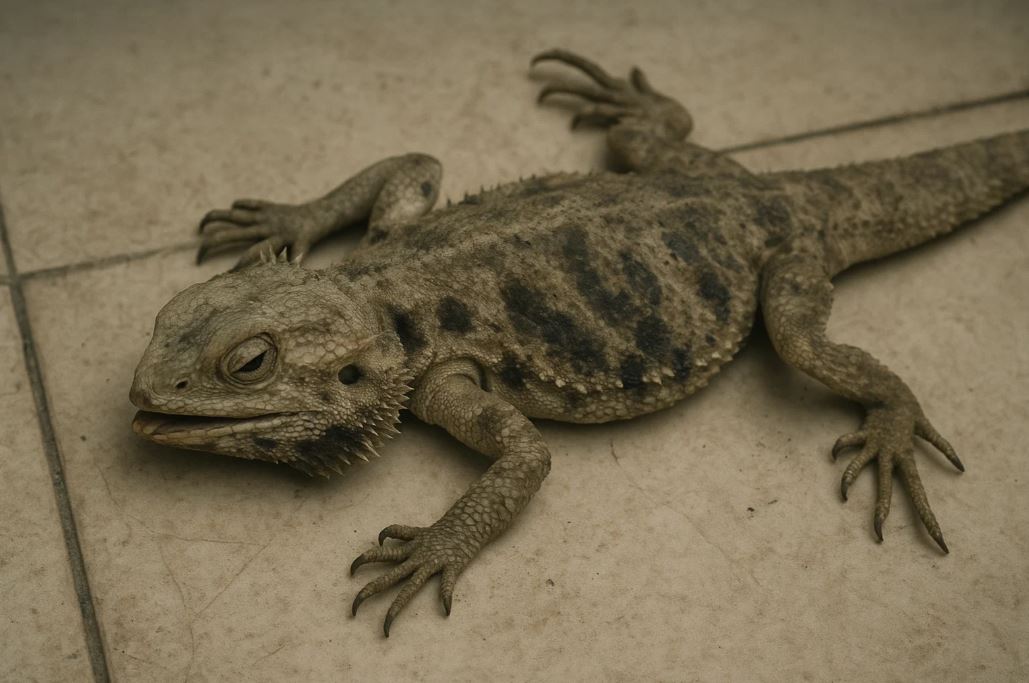What does a dead bearded dragon look like: Signs, stages, and what to check if you fear your bearded dragon died
If you’re reading this, chances are your heart is heavy with worry or grief. You’ve glimpsed something troubling in your pet’s enclosure and you’re asking: What does a dead bearded dragon look like? You deserve clarity. This article guides you; without fear-mongering; through what to expect, how death in reptiles differs from mammals, and how to approach confirming death with care and respect. The process requires patience and careful observation, much like the meticulous craft behind stunning aerial photography, where every detail matters and nothing can be rushed.
Every detail here is grounded in reptile science and community experience. I want to help you navigate this pain with facts, compassion, and useful insight.
What You'll Discover:
Why It’s Hard to Know at First
Bearded dragons (Pogona species) are not built like mammals. Their physiology and survival strategies make detecting death trickier.
- They have low metabolic rates and can hold their breath or slow breathing to near invisibility, especially when cold or stressed.
- Their heartbeats may be faint or imperceptible even in life; you might not detect a pulse easily.
- Reflexes or twitching in limbs or tail might still occur after death, confusing the issue.
- The path from life to decomposition follows stages: flaccidity → rigor mortis → relaxation again → decay.
Because of all that, the first moment you suspect something’s wrong, don’t rush to judgment. Consider this as a process of elimination. Approach it carefully, gently, and with patience.
Key Visual & Physical Signs to Look For
Here’s what you might see over time:
Extreme Stillness, No Response
If your dragon doesn’t respond to gentle stimuli; touch the toes, softly tap near the head, or reposition them; that’s a red flag. But remember: a very cold or sick dragon can become nearly “rigid” or unresponsive while still alive.
Floppy Body (Initial Stage)
Shortly after death (minutes to hours), a reptile usually becomes floppy. There’s no muscle tone or purposeful movement; limbs may splay loosely.
Rigor Mortis (Stiffening Stage)
Within a few hours (timeline depends on ambient temperature and size), the body stiffens. Limbs, tail, even the neck may lock in place. This is a classic sign. Over time, the stiffness will fade.
Sunken Eyes, Blood Pooling, Discoloration
- Eyes may appear collapsed, sunken, or glazed.
- You might see blood pooling in lower areas due to gravity, especially visible in thin-skinned parts.
- Discoloration: patches of darker or lighter color, maybe in the beard, limbs, or sides. Some owners observe the beard turning black just before or after death.
Loss of Body Warmth
In life, a reptile’s body usually mirrors ambient temperature (though basking can warm them). After death, there’s no thermoregulation, so the body gradually cools (or warms to ambient) without correction.
Softening, Swelling, and Decay
As hours pass, tissues soften, gases build in the body, swelling may occur, fluids may ooze from the mouth, nose, or vent. This stage is irreversible.
Involuntary Reflexes or Twitching
Muscles and nerves don’t shut off instantly. You may see random twitches, especially in limbs or tail. That doesn’t mean life is still there.
No Breathing, No Pulse, No Vocalization
Ultimately, there will be no observable breathing, no detectable pulse, and no vocal sounds (though bearded dragons rarely make noise).
A Timeline: What to Expect Hour by Hour
| Time Since Death | Likely Signs | What You Might See |
|---|---|---|
| 0–1 hour | Flaccidity, limp body | Limbs loose, no resistance |
| 1–4 hours | Onset of rigor | Body, limbs stiffen |
| 4–12 hours | Peak stiffness | Very rigid posture |
| 24–48 hours | Relaxation after rigor | Stiffness dissipates, softening begins |
| 48+ hours | Decomposition begins | Gases, swelling, discoloration, fluids |
Temperatures, size, and humidity all affect this timeline.
How to Check (Gently) That Death Has Occurred
Before proceeding with burial, storage, or other steps, make sure:
Warm Up Gently
If your dragon has been cold, place them in a slightly warmer area (but not too hot). If freezing was the cause of unresponsiveness, a bit of heat could revive reflexes; in rare life cases.
Test Reflexes
- Gently pinch toes or the tail tip; a living dragon will sometimes twitch reflexively.
- Shine a light near the eyes to check for pupil reaction (though in reptiles this may be weak).
- Move or reposition limbs; a living animal may attempt to resist slightly.
Check for Breathing
Use a magnifying glass or flashlight at the nostrils or chest area to see if there’s any rise/fall. This can be subtle or absent in severely ill but still-living dragons.
Seek Veterinary Tools
A vet may use Doppler ultrasound, ECG, or ultrasonography to detect faint cardiovascular activity.
If none of these signs of life present and the body shows persistent stiffness, sunken eyes, discoloration, and no response even after warming and retesting, death is nearly certain.
Common Misconceptions & Pitfalls
Brumation Is Not Death
Brumation is a reptile “hibernation” state where metabolism slows drastically. Dragons may sleep deeply, barely move, and eat little. But they still respond sometimes (slow movement or shifting). A brumated dragon may awaken if warmed.
“He’s cold and stiff” ≠ dead
Cold temperatures cause stiff muscles. Without metabolic warmth, a living but chilled dragon can appear rigid. Always warm first before making judgments.
Twitching after death
Reflex twitches, post-mortem contractions, or nerve reactions are not signs of life. They’re part of the biochemical breakdown.
Discoloration or darkening of beard
Some owners report the “beard turns black” as death approaches. That’s not a reliable universal sign; stress, temperature, or mood can also darken the beard.
What the Reference Image Suggests
In the image you attached, the dragon:
- Appears limp, with no tension in limbs
- Has partly closed, glazed eyes
- Has a relaxed jaw (mouth slightly open)
- Displays muted coloration, not vibrant or alert
- Shows no signs of breathing movements or muscle tone
These are all consistent with a dragon that is past the point of life. Still; until a vet confirms, you proceed as though uncertainty remains.
What to Do Next (If You Confirm Death)
Pause Before Any Action
Body handling, burial, or freezing too soon could complicate your decision or grief process. Many keep the body in the enclosure or in a cool, dry place for 24–48 hours while monitoring and reflecting.
Decide on Final Disposition
- Burial: Select a site deep enough to avoid scavengers.
- Cremation: Some exotic vets or pet cremation services offer this.
- Freeze First: Many people freeze the body (in a bag) before final choice, which slows decomposition.
Clean & Disinfect the Enclosure
Use reptile-safe disinfectants. Any leftover substrate, hides, or décor should be cleaned thoroughly or replaced.
Learn & Reflect
Review husbandry (lighting, temperature, diet, UVB) to understand what went wrong and help future pets. It’s not about blame; it’s about insight.
Grieve
Losing a pet reptile is real grief. Talk, journal, memorialize them. A bond of reptile-and-human is valid and important.
How This Differs from Mammalian Death
- In mammals, breathing stops, heart stops, eyes glaze over; often visibly fast. With reptiles, metabolic suppression, reflex persistence, and slow breakdown blur these boundaries.
- Mammals quickly go rigid then relax; reptiles may maintain stiffness longer.
- Visual signs (like open eyes, slack jaws) are less reliable in reptiles.
- Physiological checks (ultrasound, ECG) are often required in reptiles to confirm death, even when signs seem obvious.
What People Say…
One keeper shared this:
“I found my beardie midday, wedged under a log. She was floppy with a very soft stomach. A few hours later, rigor mortis set in.”
Another case:
“We thought he was dead; no response to taps. But after a warm bath, he awoke, though the beard was dark. We’d rushed.”
These stories highlight danger in assuming death prematurely. Time, warmth, and gentle stimulus sometimes reveal life otherwise hidden.
When to Involve an Expert
- You cannot detect a heartbeat or breathing using normal means
- You see an unresponsive animal but suspect deep torpor, hypothermia, or illness
- You want confirmation before burial or cremation
- You suspect poisoning, trauma, or disease may have caused death
A vet (exotic or reptile-savvy) can use Doppler, ultrasound, or ECG techniques to confirm.
Key Takings
- Dragons don’t “look dead” in one instant; it’s a process of flaccidity → rigor → relaxation → decay
- Warm the body gently first; stiffness doesn’t always mean death
- Check reflexes, breathing, eye response, but they may fail even in life
- Discoloration, sunken eyes, pooling blood and no response over time strongly indicate death
- Allow 24–48 hours of observation before final decisions
- Use vet tools for final confirmation when possible
- Handle the body respectfully, clean habitat, and reflect on care to learn
- Grieving is natural; your dragon mattered
Additional Resources:
- Reptile Medicine and Surgery: Comprehensive clinical resource on reptile health diagnostics and surgical interventions.
- Veterinary Clinics of North America: Exotic Animal Practice: Scientific journal focusing on protocols, case studies, and advances in exotic pet care.





